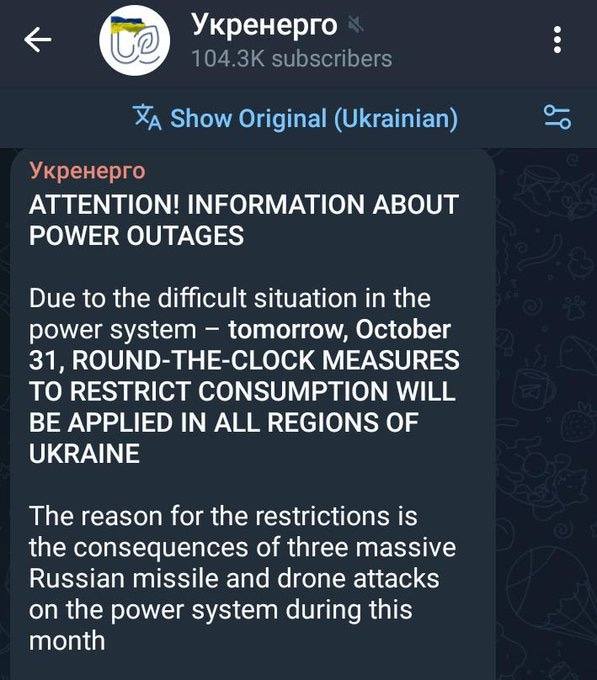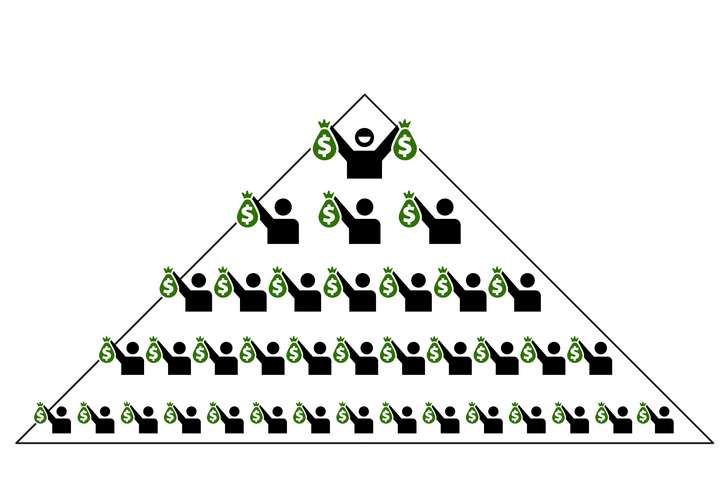Russia has just stepped up its electricity war, via making its biggest use of ballistic missiles in a single night of strikes on the electrical grid, focused on thermal power generation and knocking out all of those stations, plunging all of Ukraine’s major cities into darkness. Russia has also just captured the key city of Pokvrosk a critically important logistical hub. Per some accounts, Putin has ordered the cauldron to be closed, reportedly only the second time since the capture of Mariupol. As a matter of practice, Russia has generally instead created big encirclements but left an avenue out. That has worked particularly well in Ukraine give Zelensky’s predictable orders to hold territory at all cost. Ukraine keeps feeding men and material into a Russian maw.
Pokvrosk has fallen .🇧🇬https://t.co/IqV9Sdknoh
— Sol Feiz (@Feiozol) November 7, 2025
See History Legends from a few days ago for more on the fall of Pokvrosk. Last week, Simplicius gave an overview of the battlefront decay:
The most revealing fact about Russia’s sudden breakthroughs on every front is that these do not appear to be coming at the expense of major mechanized assaults with huge losses as some of Russia’s previous official ‘offensives’ had done. Sure, there have been a string of mechanized assaults we’ve covered in the past couple weeks, but these have mostly come at secondary fronts; for instance, western Zaporozhye, around Orekhove, in Shakhove, north of Pokrovsk, etc.
The main fronts discussed earlier all seem to be collapsing to the same old trickle and ‘thousand cuts’ tactics. Most importantly what this means is that Russia does not appear to be paying an exorbitant cost in casualties and equipment for these recent successes, other than expendables like bikes, civilian cars, bukhankas, etc.
If this is truly the case, this bodes extremely badly for the AFU. It would mean a point of no return has been reached where Russia no longer has to expend outsize resources for these accumulating breakthroughs, which means they will only continue unabated.
We don’t know for certain if this is the case; for instance, the fact that this sudden collapse of the AFU has corresponded precisely to the advent of rasputitsa and other inclement winter-like conditions could mean this has more to do with Russia’s recent surge. But as I’ve stated many times before, Russia has always had its biggest campaigns during the winter, wherein the Bakhmut and Avdeevka operations were carried out.
However, Russia’s trump card has been and remains its ability to destroy or cripple Ukraine’s power supplies. The start of Dima’s video shows the day after impact of the latest electricity attacks….which in a lot of cases will extend beyond that:
The Guardian has a day-later account trying to put a brave face on the power system strikes:
Power will be cut for between eight and 16 hours across most regions of Ukraine on Sunday, state transmission system operator Ukrenergo has said, after Russian attacks targeting energy infrastructure reduced the country’s generating capacity to “zero”….
Ukrenergo has said repairs were carried out and energy sourcing diverted.
While the situation had somewhat stabilised, regions including Kyiv, Dnipropetrovsk, Donetsk, Kharkiv, Poltava, Chernihiv and Sumy could continue to experience regular power cuts, Ukraine’s energy minister said on Saturday night…
Experts have said the strikes on energy infrastructure put Ukraine at risk of heating outages before winter. Russia has targeted the power and heating grid throughout its almost four-year invasion, destroying a large part of the key civilian infrastructure.
This weekend’s attack was the ninth massive attack on gas infrastructure since early October, Ukraine’s energy company Naftogaz said.
Kyiv’s School of Economics estimated in a report that the attacks have shut down half of Ukraine’s natural gas production.
Ukraine’s top energy expert, Oleksandr Kharchenko, told a media briefing Wednesday that if Kyiv’s two power and heating plants went offline for more than three days when temperatures fall below minus 10C, the capital would face a “technological disaster”.
The article did not explain what “technological disaster” would amount to. But our understanding is the municipal water supply depend on electricity both to keep pipes from freezing and for pumping. Knowledgeable readers might also be able to describe the risks to the sewage system.
And Ukraine officials were warning even before this big attack that residents of big cities like Kiev who depend on electric power for heating should make backup plans to decamp to spots with furnaces. From Simpilcius on November 2:
At the same time, Russia’s strikes on Ukraine’s power grid have been the most determined they’ve ever been, with many noting ‘unusual’ behavior such as doing double-taps on repair crews and launching giant drone swarms on each facility, rather than simply one or two missiles. Several Ukrainian officials have already called for people to abandon Kiev as they warn it will be without heating for major parts of the coming winter.
Ukraine’s main energy authority Ukrenergo:

These developments suggest a new-found bloody-mindedness on the part of Russia, perhaps reflecting Russia’s recognition that the time is ripe for a decisive push. Another factor may be Trump’s shameless peace theatrics, of embarrassing Putin by calling him and springing the scheme of a “possibly Budapest” summit on the Russians, to which after a short period of regrouping, they agreed, and then going into Emily Litella “Never mind” mode.
But Trump also retraded his earlier commitment, after the Alaska summit, to abandon his “ceasefire first” position. The Russians rejecting that, as they consistently had, was apparently the trigger for Trump scuppering the idea of another summit pronto. In two long interviews, Foreign Minister Lavrov has described how Witkoff came to Moscow for a >3 hour meeting with Putin and set forth a US proposal, which Putin agreed to discuss as the main menu item at the Alaska summit. Putin then in person with Trump went over the Witkoff terms in detail and Trump confirmed that they were indeed acceptable to the US. It is this very own Trump scheme that Trump has now repudiated. This brings the idea of “not agreement capable” to an entirely new level.
Trump also seems to be back to buying Ukraine propaganda intel that Russia’s military and/or economy are gonna fall over soon, yes siree Bob:
TRUMP DROPS C WORD FOR C WORD – Trump has again abandoned immediate CEASEFIRE and now expects CAPITULATION: “Sometimes people have to fight it out a little bit longer” https://t.co/EUoDk7CFp3 pic.twitter.com/KIOWRQN7xz
— Dances_with_Bears (@bears_with) November 7, 2025
Lavrov has ritually said that Russia is still willing to work with the US on the Alaska “understandings”. The kinda-sorta face saver for Trump is that he apparently also represented to Putin that he could make Ukraine to accept this deal. Trump clearly has the means to do so. But he went TACO after press and official hysteria about the mere fact of the summit on US soil, and then meetings with Zelensky and EU officials shortly thereafter. But the message from the US is that it can do what it wants to and the other side should swallow that. So despite making obligatory US friendly-noises, it seems that Putin and others favoring a negotiated settlement can no longer pretend to themselves that there might be a resolution other than Russia imposing a military outcome.
Perhaps things have changed, but Alexander Mercouris reported that Ukraine forces were ordered to move east to Myrnograd, which is rearranging deck chairs on this Titanic and assures their destruction or capture. Even though Western sources are set to minimize it, the capture of Pokvrosk is an inflection point. Russia now has the war for the Donbass in the clean-up phase, even though that will require more expenditure of lives and materiel to complete. Russia could choose to strike West through relatively thinly populated areas to the Dnieper, which would focus a lot of minds. But without knowing the Russia and Ukraine disposition of forces, as we’ll discuss soon, there are reasons for Russia to finish the job in the east and take the last, much less formidable fortified line at Sloviansk and Kramatorsk first.
John Helmer, who has provided far and away the best accounts of the electricity war, confirms that the latest grid salvo reflects a Russian decision to pick up the tempo on this aspect of the war. Helmer’s sources contend that Russia could have ended the war much sooner with a sustained full bore attack on power sources and delivery, but Putin held that back for political reasons. Helmer does not unpack what they are, but we will make a stab at what ones are likely still operative. We’ll see that even with Russia more and more clearly getting the upper hand on the battlefield, that other considerations don’t clearly point all in one direction. We’ll discuss below how despite Russia just having given a stark preview of its ability to bring Ukraine to its knees quickly, Russia still has reasons to keep grinding out the war on the ground.
But first to Helmer on the acceleration of the electricity war:
Over the last three days the General Staff’s electric war strikes have continued to intensify on their targets and extend right across the Ukraine, with local utility companies announcing blackouts from Kharkov in the east to the western regions…
Russian military analysts are well aware and are now reporting that since the electric war campaign first began in October 2022, the number of strikes has been limited in duration, firepower, and damage effected….
But not this time, military sources in Moscow believe.
Some of the sources have claimed the General Staff did not have the capacities to fully implement the electric war in the first two years…
Other sources believe the military resources, logistics pipeline, targeting intelligence, and weapons accuracy and survivability were not as available to the General Staff in October 2022…
One source says that President Vladimir Putin imposed restrictions on the extent and duration of the campaign but gradually he has been persuaded to relax them…
A source in a position to know says the restrictions on the electric war have been political, not military, and for the time being Putin appears to have lifted them.
“I have a tough time believing that the General Staff did not have the intelligence, let alone the weapons accuracy and survivability necessary to prosecute the electric war from the start,” the source comments. “First…Information on the Ukrainian electrical generation, transmission, and distribution network was, and still is, widely available in open source. There is no way that the electrical or civil engineers employed by the General Staff could not know what to target and what firepower was necessary. In terms of weapons, the Russian forces had then, as they do now, stocks of cruise, ballistic, and other air-dropped weapons, not to mention sabotage capabilities, to destroy the critical Ukrainian electrical nodes. There are approximately 35 major Ukrainian substations…Looking at the data provided in these sources, the General Staff have had more than enough ordnance to take them all out. They didn’t. Moving forward from this line of thinking, I am curious to know why Ukrainian electrical laydowns [storage areas] and service vehicles have not been targeted. Are we to assume these could not be seen? This defies rudimentary understanding of enemy logistic and repair capabilities. Quite obviously, the delay to date in achieving the complete collapse of the Ukrainian grid was and is the product of political decision-making, not any lack of capability on the Russian military’s part.”
Let’s go through some of those “political” considerations that still complicate Russia simply turning out the light and heat all over Ukraine:
Not producing a humanitarian crisis. It’s hard to wage war without killing a lot of civilians but Russia has made an earnest attempt so far. The strongest evidence of Russia trying to spare bystanders is that Russia did not take destroy Ukraine internet, television, radio and cell phone facilities as soon as possible. Ukraine has gotten so used to getting easy handling that there was whinging about the loss of Internet services along with the big power outages.
Some of the thorny related problems:
With by some estimates half of the Ukraine population already having left, those that can’t leave (or even get to housing heated by furnace), those who remain will skew to the elderly and infirm. Russia has managed to persuade its economic allies and the Global South that it is keeping to the high ground as much as possible given the givens. That could evaporate rapidly if power outages produce large scale deaths from cold and disease in Ukraine cities.
Is Russia going to be able to provide enough in the way of relief operations quickly enough and on a large enough scale in winter conditions to prevent widespread hardship?
Any of a food, water, or medical supplies crisis in a big Ukraine city could serve as a pretext for sending in troops from EU member states, allegedly to provide relief.
“You broke it, you own it”. It is not clear that the Russian leadership has made a decision on how much of Ukraine, ex the oblasts it deems to be part of Russia, that it will need to occupy or otherwise put under friendlier management. As N/A pointed out:
Also as I’ve said countless times. These two nations are very well integrated with each other. This isn’t Germany or Britain or America. You would see a much more aggressive war against those than on Ukraine or Belarus or countries like that. Moldova as well https://t.co/97T0t8rv8W
— N/A (@xLUHG333) November 8, 2025
I agree with Mark Sleboda’s case as to why Russia controlling all of Ukraine is Russia’s least bad option. But that does not mean Russia officials, who have a much more comprehensive view, will come to that conclusion. But Russian hard-liners favor that outcome, so it will get consideration.
Reality is starting to regime and attitude-change some of Russia’s fierce opponents. Too many European leaders are still determined to Do Something to stop Russia from rolling into Paris. The problem is that even with their limited military means, they could still trigger a hot war, for instance, with their drone and balloon false flags justifying a confrontation, say in the Baltic. Since both the UK and France have nukes, they cannot be completely discounted as powers. Undue belligerence and persistent stupidity could produce very bad outcomes. And the US has not given a firm no to the idea of deploying the nuclear-capable Tomahawk missiles to Ukraine either.
But Brussels again nixed seizing Russian frozen assets, since other states are not willing to indemnify its ginormous legal risk. And Slovakia has thrown another spanner, saying it will not back using the funds if they go to war-making.
This row over cash is more central than it might seem, since both Europe and the US both labor under the delusion that if they throw enough money at the problem, weapons can be magicked into existence. But, quelle surprise, they can’t even come up with that! From Euronews:
According to sources close to the discussions there’s growing concern in the Belgian government at the lack of alternative proposals from the European Commission to using frozen Russian assets to fund Ukraine.
The EU is pushing for a plan to use €140 billion in frozen Russian assets held at Belgian financial repository, Euroclear…
The Commission is looking for ways to maintain Ukraine’s funding stable going into 2026 as the costs associated to the war mount without US support, which has declined since President Donald Trump took office…
“To be frank, we are still waiting for the other options that the European Commission was meant to present, as agreed at the European Council” in October, they [Belgian sources] told Euronews…
“You cannot take the best decision if you don’t have all options with its positive and negative sides”, said the source.
If the plan fails, some options floated in formally include issuing joint debt, bilateral provisions from member states or a short-term bridge loan. Member states privately admit none of them would be as significant or stable as the reparations loan.
But the funding row is intensifying the pressure on European national budgets, where governments are unpopular and falling due to already having made social spending cuts, and it has become all too obvious that supporting Project Ukraine and an open-ended low level war with Russia means even more of the same. How long, for instance, can France effectively have no government as Macron refuses to call Parliamentary elections, which would confirm the popularity of the anti-war left and right?
So since Putin cannot have his long-sought new European security architecture, perhaps a next-best would be a Europe so divided on what to do about Russia so as to be immobilized.
So Russia has finally made clear that it can, quickly and with comparative ease, prostrate all of Ukraine. If anyone in senior positions in Ukraine was still in denial, this demonstration ought to have driven that fact home.
One reason to keep pushing Ukraine to or over the brink is to force the government in Kiev to capitulate. Russia no doubt has a much better handle on the true state of top level cohesiveness than anyone in the chattering classes. But Zelensky may have too many diehard Banderites around him to do anything other than stay his present course or flee with key figures to set up a government in exile.
A possible surgical use of Russia’s electricity war weapon would be to force the surrender of key Ukraine cities. For instance, Russia has yet to capture a city as large as either Dniepro or Zaporzhizhia, both of which it deems to be part of the Russian Federation. Russia could march forces up to the outskirts of one of these cities, and then announce it will deprive them of power unless and until they surrender. It could also have emergency supplies and transport at ready so as to support residents who chose to decamp rather than try to hold out. Russia could hone this approach on these Russia friendly cities, and next Kharkiv, and then if needed keep rolling westward.
Again, this is an overly dynamic situation. Russia still has many, complex choices to make and tradoffs to weigh. But the end game is under way.


























